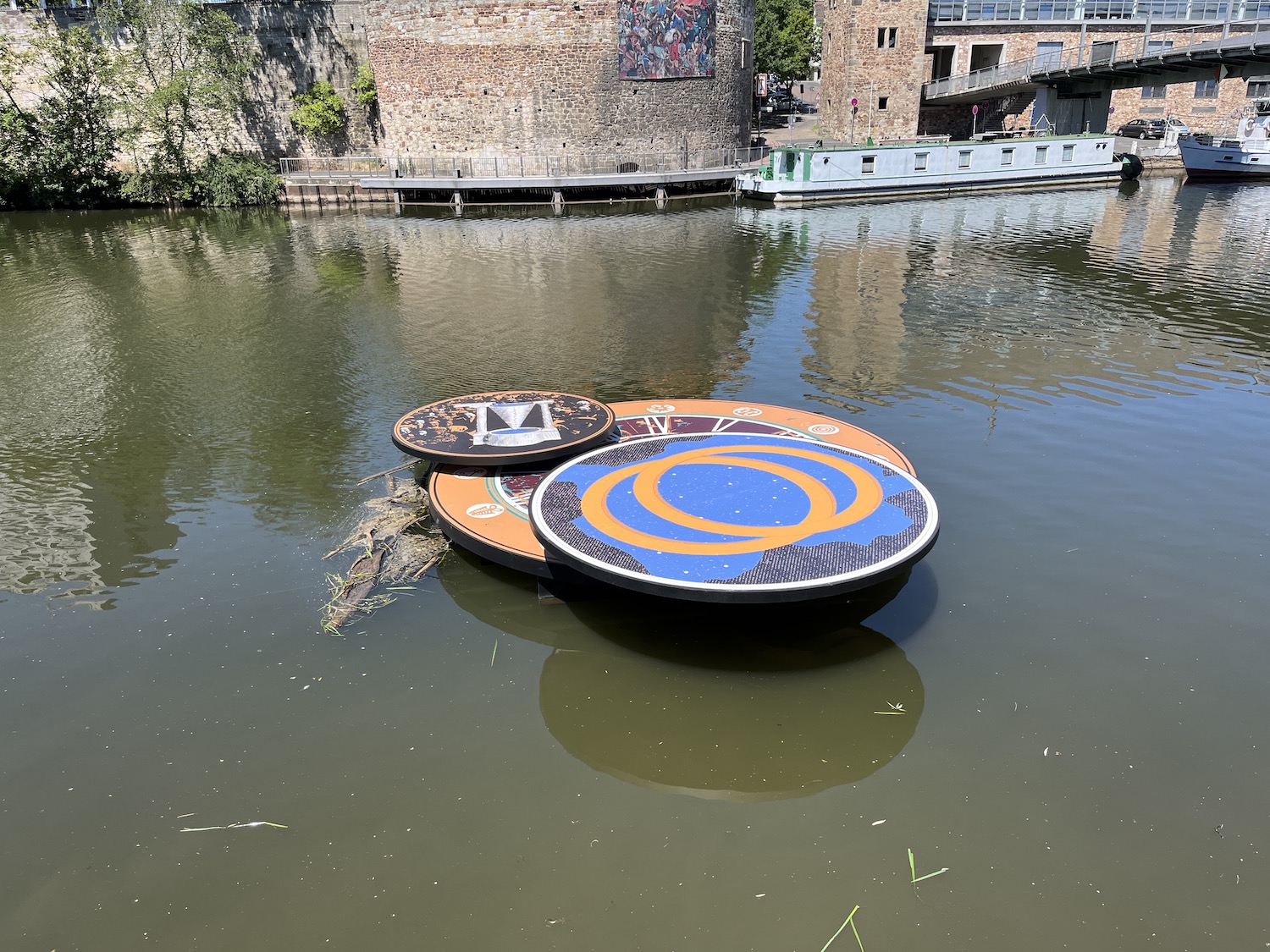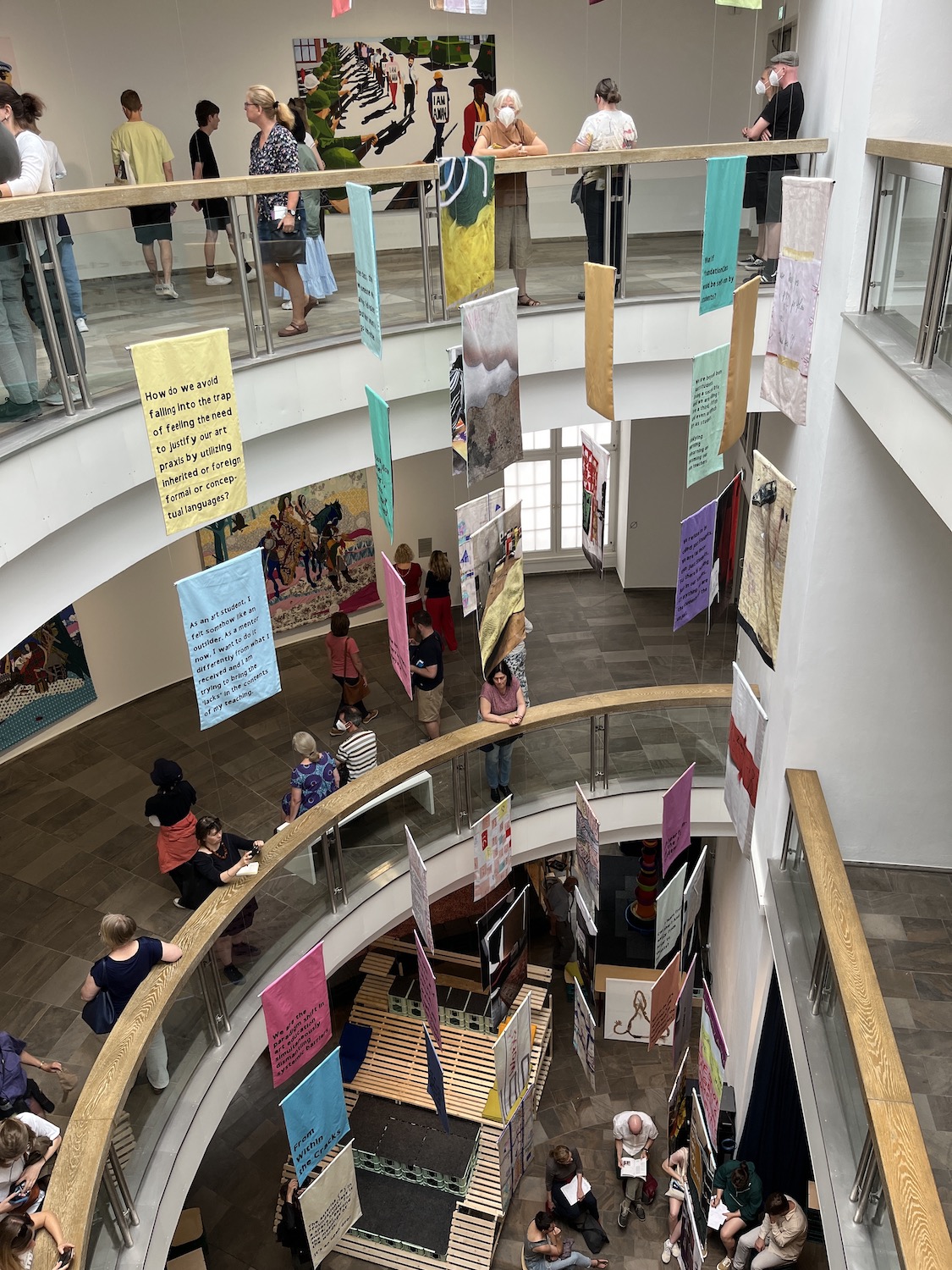The first iteration of Documenta, curated by Arnold Bode, took place in 1955. Since then, every five years for 100 days, Documenta occupies the city of Kassel, Germany. More often than not, it is an international showcase of current trends and ideas in contemporary art. A curator or curatorial team is chosen and given carte blanche to put together the exhibition. During the 100 days, thousands of visitors descend upon Kassel to see hundreds of exhibits presented in venues located all over the city. For 2022, the collective Ruangrupa, based in Jakarta, Indonesia was chosen as curators. This is the first time that artists have had curatorial control of Documenta and their exhibition has a different tone and attitude than any of the others. While Ruangrupa’s work (in the form of a radio station) was exhibited in Documenta 14, it came as a surprise that they were invited to organize Documenta 15. Documenta 15 opened amid controversy: accusations of antisemitism and the resignation of the director general of Documenta have continued to plague the exhibit.
Ruangrupa has based Documenta 15 upon the values and ideas of lumbung — principles of collectivity— and one of the aims of their exhibition is “to create a globally oriented, collaborative and interdisciplinary art and culture platform that will remain effective beyond the 100 days.” Another focus of Documenta 15 is accessibility and sustainability. As the curators state, “The theme of sustainability is reflected throughout all aspects of the exhibition planning and implementation.” Documenta 15 features over thirty venues and for the first time in Documenta’s history, the ticket to the exhibition provides free access to public transportation. Other implementations of sustainability are the myriad gardens created by artists and collectives invited to participate in the exhibition. Visitors to Documenta 15 expecting to be wowed by paintings and sculptures might be disappointed as Ruangrupa’s curation does not celebrate aesthetics, but rather promotes discussion and community. It is interesting to think about how works made by artist/activist collectives and notions of community translate into Art. In fact, many of the installations are text based, instructive, didactic and not always visually compelling. While Documenta is somewhat of an urban experience, Ruangrupainvited collectives that prepare food, create gardens, as well as spaces to gather, converse and perform in parks and neighborhoods across the city. Sadly, during my visit because of a Covid outbreak, all gatherings, tours, films and lectures were canceled.

Black Quantum Futurism at Documenta 15, 2022
There are many trajectories through the numerous Documenta 15 venues. Most people begin at ruruHaus which serves as the welcome and information center. Here one can get a ticket, maps, a snack, use the restrooms, peruse the bookshop and view an informative timeline that outlines the complications (Covid 19, supply chain delays, visa and travel issues, heat waves, the war in the Ukraine) that hampered the production of the exhibition. In most years, the main venues for the exhibit are the Documenta Halle and the Fridericianum located in the center of the town, as well as the large grounds of Karlsaue Park. Artworks are also often installed in underpasses, at the train stations and in Kassel’s art and historical museums, as well as in nontraditional locations and buildings secured for the duration of the exhibition.
With more than 1500 artists/exhibits it is impossible to quantify the experience. What follows is what resonated during my four days in Kassel.
For those who arrive at the Kassel KulturBanhof, they can visit a small installation by Jimmy Durham and A Stick in the Forest, a collective formed after the artist’s death. Outside the station are Dan Perjovschi‘s drawings on painted white rectangles scattered across the pavement of the plaza. These poignant, cartoony, doodle-like drawings offer commentary on art and current events. Perjovschi’s work also covers the columns outside the entrance to the Fridericianum. Toward the edge of town is the Hallenbad Ost (an old pool house that was empty for many years and recently rebuilt) where the Indonesian collective Taring Padi has installed a twenty-year survey of their work. Outside the building are hundreds of life-size painted cardboard cutouts (these are also presented inside and in front of many of the other locations) depicting various characters proclaiming different social, political and cultural issues. Nearby was St. Kunigundis, a Roman Catholic Church built in 1927 where members of the Hatian groups Atis Rezostans | Ghetto Biennale presented works that encompassed many media. Hübner Areal, (a recently vacant factory that used to build parts for buses, trains and tanks) is a huge warehouse-like space that houses works by many different artists and collectives. The installation has the feel of a funky art fair where there are no dividing walls to separate the projects. Included here are spaces for discussions and performances, as well as works that span the walls, floors and ceiling. The collective BOLOHO turned the factory cafeteria into a Cantonese-style cafe open to all. In another multi-floor, multi-artist building Hafen-strasse 76, were works by Nino Bulling (hand-painted drawings on silk suspended from the ceiling that expanded on their book abfackln) and Fehras Publishing Practices, a queer collective based in Berlin that investigates Arab-language publishing, has created a photo-narrative spanning more than 100 panels that focuses on the feminist women behind the Afro-Asian Solidarity Movement.

Taring Padi at Documenta 15, 2022
Along the Fulda river are works by Black Quantum Futurism and the Nha San Collective who erected a bench on the bridge, as well as Nguyen Trinh Thi‘s projection / sound work housed within the Rondell, originally a defense tower built in 1523 that now serves as an exhibition space. Nguyen’s evocative and peaceful piece consists of projected silhouettes of plants complemented by a haunting soundtrack. The work is based on the autobiographical novel by Bui Ngoc Tan, Tale Told in the year 2000, about life in detention camps in Vietnam in the 1960 and 70s. Other works in situ include: The Nest Collective who have created a walk in sculpture (that houses a video projection) made from large parcels of industrial and plastic waste, a giant compost heap, an active green house garden, as well as a sculptural tower that serves as a his/her public outhouse, a contribution by Mas Arte Mas Accion.

Fridericianum interior, Documenta 15, 2022
Inside the Fridericianum, it is a bit of a chaotic mish-mash. Upon entry, viewers are greeted by Dan Perjovschi’s full-scale wall-work that annotates and comments upon the Documenta 15 funders. To the left, the space is devoted to RURUKIDS, which is in essence, Documenta daycare (closed due to Covid concerns during my visit): a space where parents and children can learn and play. Also located within the Fridericianum (as well as other venues) are quiet rooms where people can take a break from stimulation, sit in silence and stare at unadorned walls in a darkened space. On the top floor are pieces by Project Art Works, a group from Great Britain that works with people with learning disabilities, or who are neurodivergent, to explore their creative potential. Displays of films and ephemera from The Black Archives, the Asian Art Archive and the Archives des luttes des femmes en Algerie are full-fledged historical exhibitions nested amongst works by individuals and other collectives. One of the few painters given a solo presentation is the Aboriginal artist and activist Richard Bell. Bell’s flatly rendered representational paintings depict protests and conflicts. He states that his works explore ” the complex artistic and political problems of Western, colonial and Indigenous art production.” Also in the Fridericianum are films by artists from the collective Sada [regroup] who came together in Baghdad from 2010-2015. This included a compelling short film Journey Inside a City by Sarah Munaf, about the after effects on Iraqi artists from the U.S. war to remove Saddam Hussein.
Adjacent to the Fridericianum is Documenta Hall and the Museum of Natural History Ottoneum. The entrance to Documenta Hall has been transformed by Nairobi based, Wajukuu Art Project into a tunnel made of corrugated metal that also covers many of the interior walls and windows, setting a tone that celebrates makeshift architecture. The corrugated metal reappears on the lower level of the Documenta Hall where one finds not only a functioning print shop that produces books and posters for the exhibit, but also a skateboard ramp and performance stage orchestrated by Baan Noorg Collaborative Arts and Culture, a collective from Thailand. The lower level is an active, dynamic space where viewers can hang out and interact.

Richard Bell at Documenta 15, 2022
Among my favorite artworks at Documenta 15 are a two channel video projection located in the Ottoneum by Korea’s Ikkibawikrrr collective. This subtle and compelling 12 minute loop titled, Tropics Story, pictures war remnants at locations formally occupied by the Japanese Empire that include images of “overgrown airstrips, abandoned cave fortifications and burial grounds that hint at how war is metabolized by nature.” In the Grimmwelt Kassel, a museum showcasing the works of the Brothers Grimm, is a multi-media installation by Jarkata’s Agus Nur Amal who creates his own fairy-tales and story telling session on the top floor of the museum. Perhaps the most memorable space and installation was Erick Beltran‘s Manifold at the Museum for Sepulchral Culture— a space that collects and showcases works about the global rituals around death and dying. For Manifold, Beltran has created a series of hanging banners and wall mounted murals filled with texts and diagrams that explore the peoples’ conception of ‘images of power.’ This complex installation also includes sculptures and a video where these images of power are animated to illustrate the relationships between them.
The takeaway from Documenta 15 is that art can’t be separated from life. Much of what is on view is didactic — with prescribed political agendas, about social issues and made by collectives rather than by individuals— hard to digest and overwhelming to experience all at once. Yet, Documenta lasts 100 days and during this time, the gardens will grow, people will gather and the spaces and the exhibits will change. Those who can spend ample time investigating the myriad notions of collectivity will come away enriched. Those only looking for visual pleasure may come away disappointed.
Documenta 15
June 18 – September 25, 2022
Kassel, Germany


